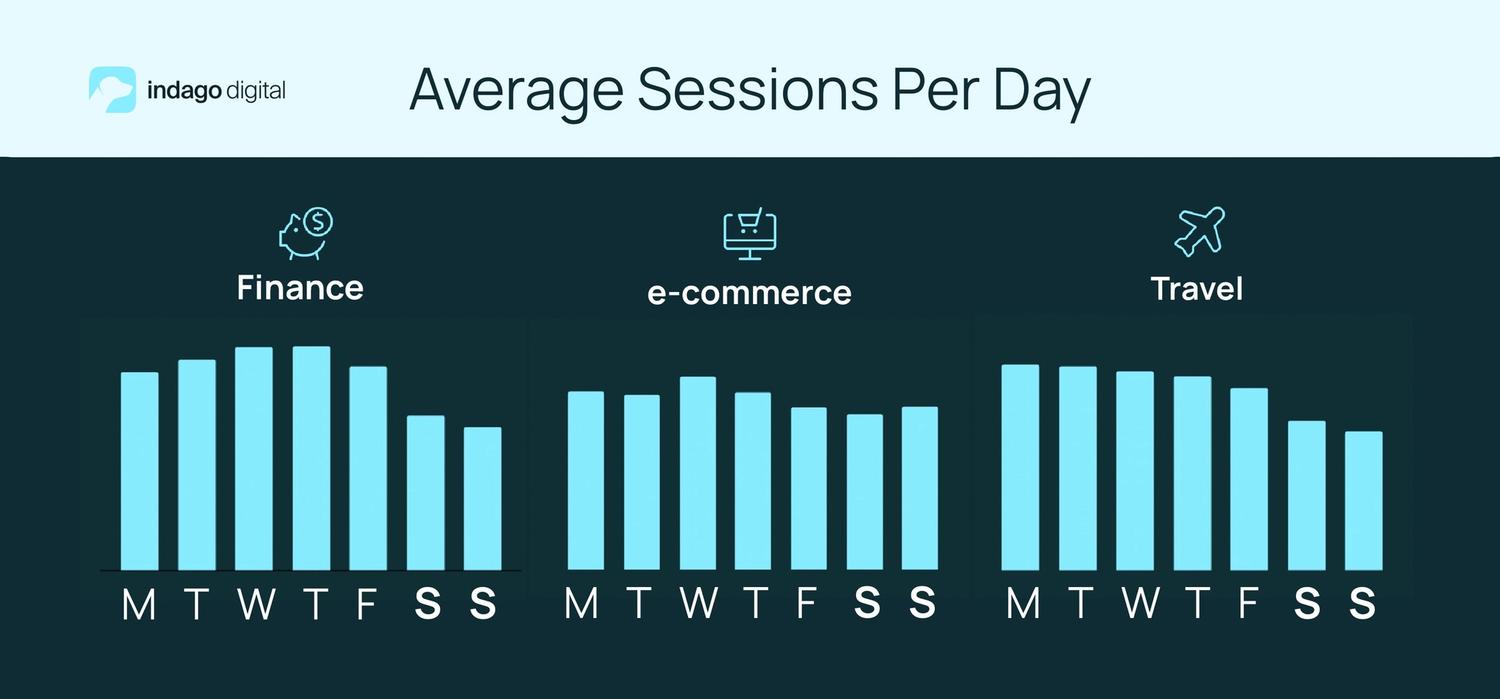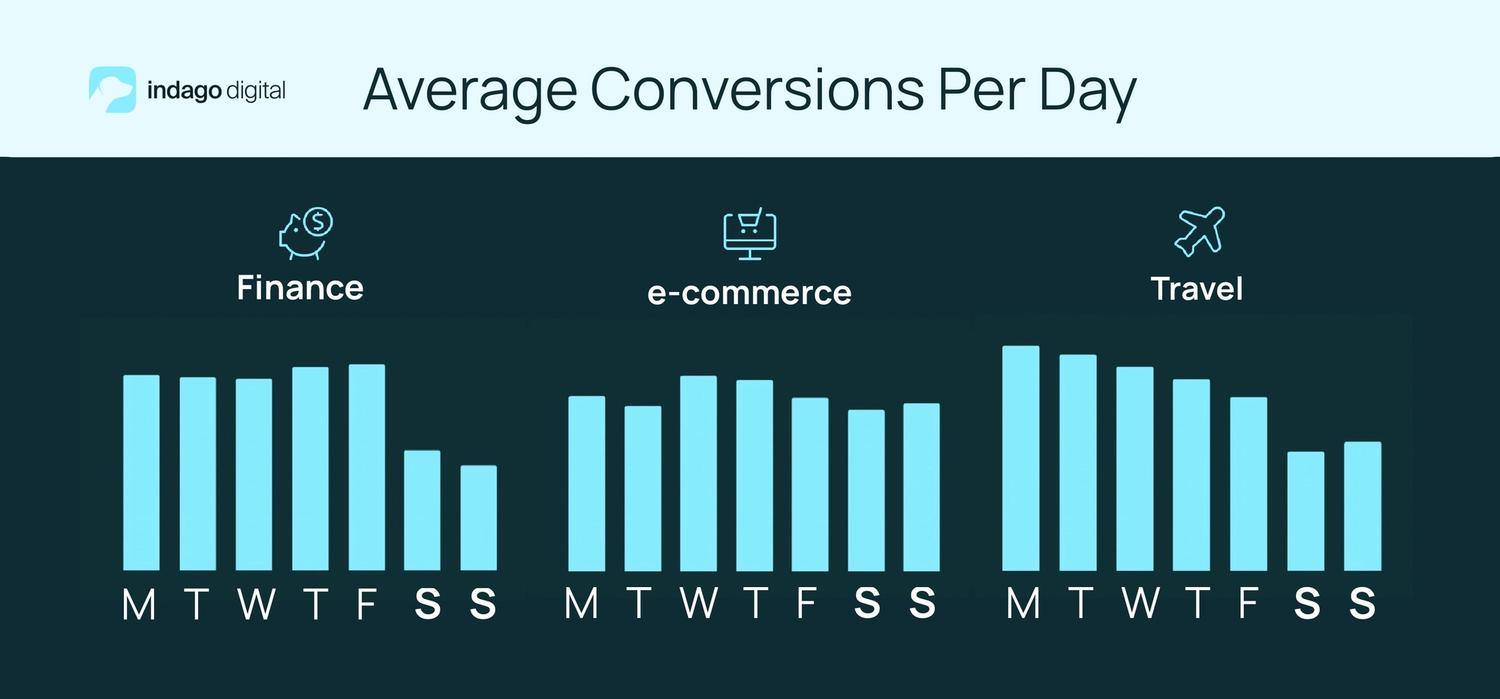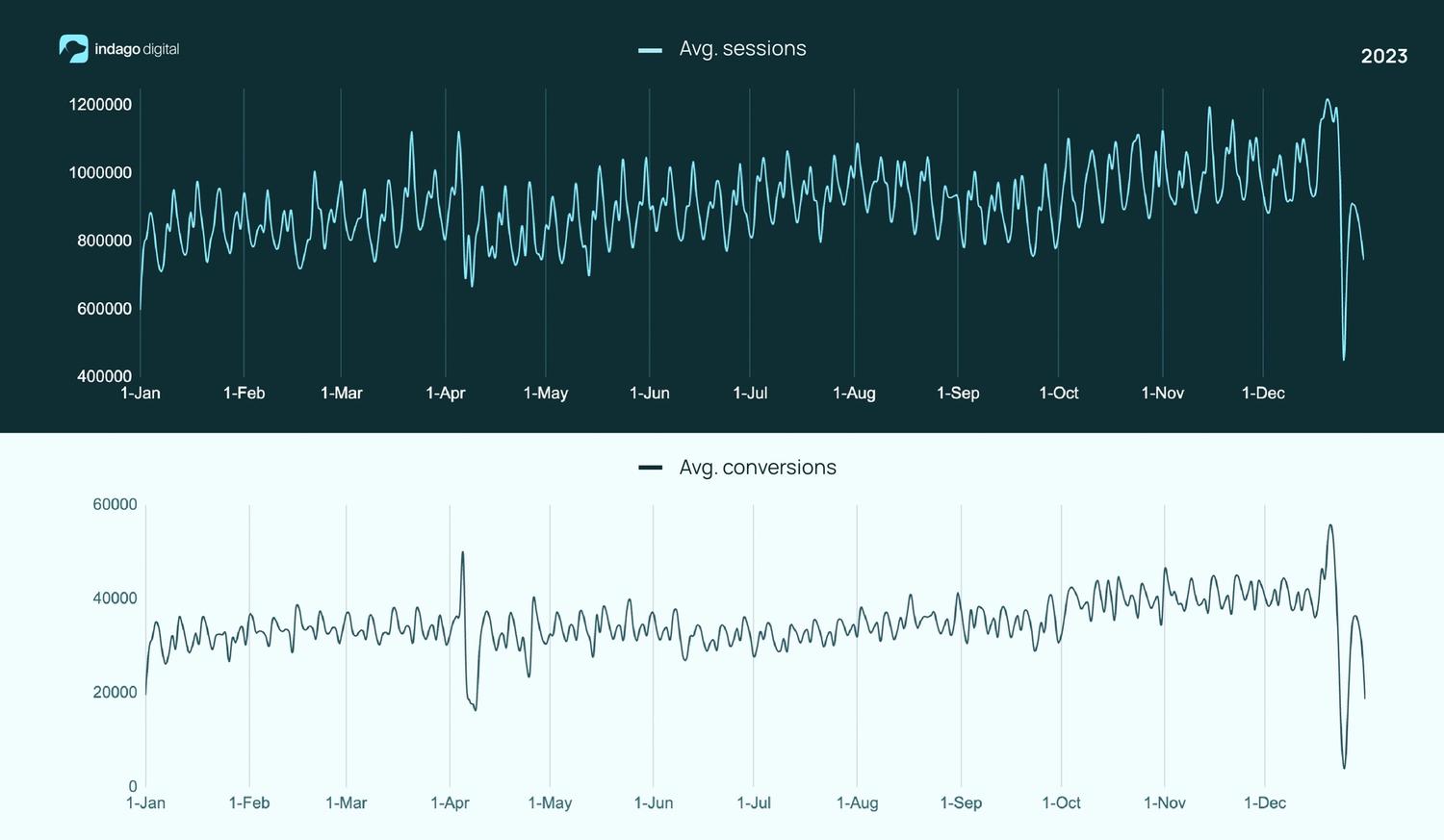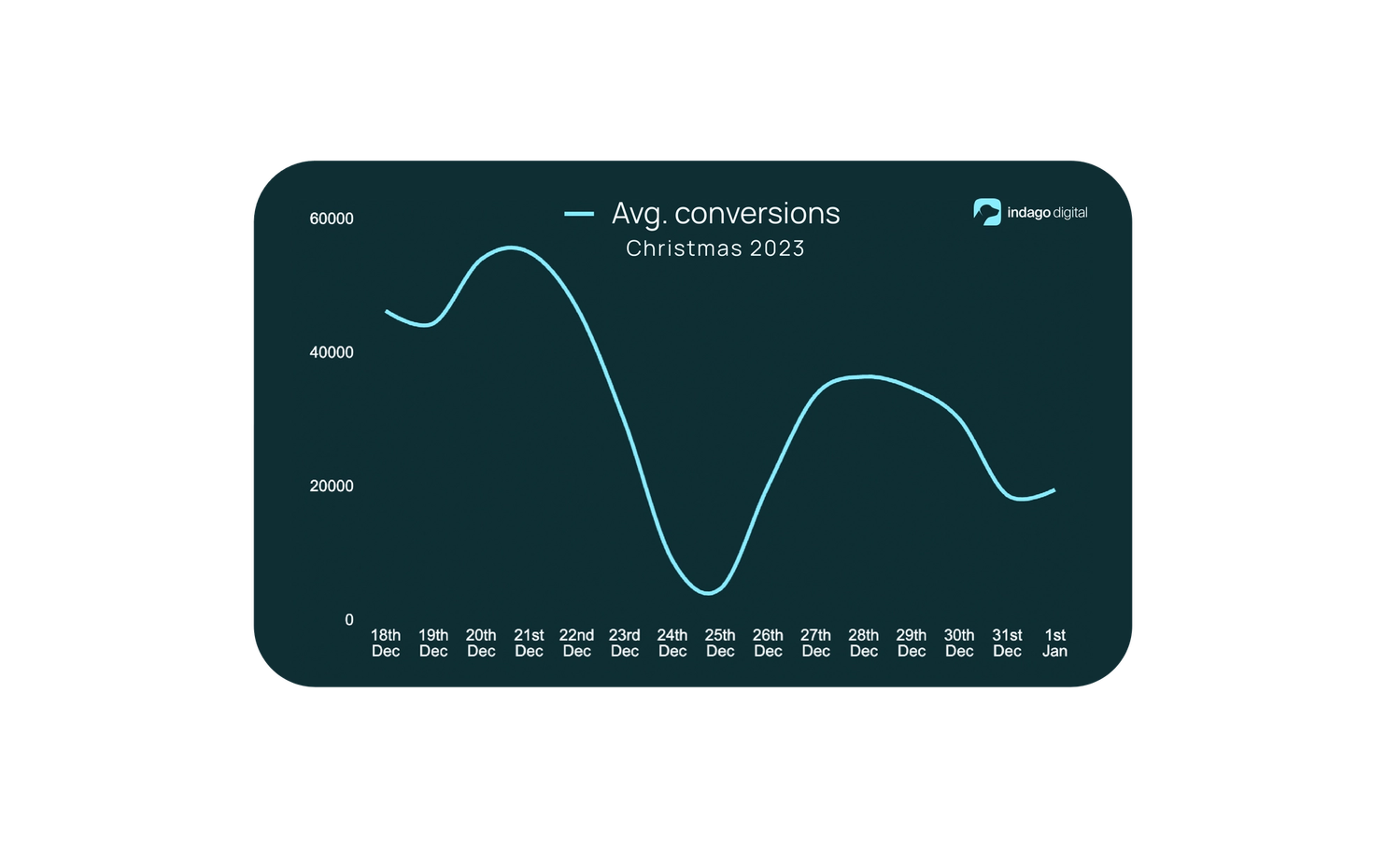How is forecasting used in marketing?
Marketing forecasting is all about digging into historical data to predict future trends, consumer behaviours, and market demand. Forecasting based on historical data can help you make smarter decisions about when to pivot, pull back, or ramp up your marketing efforts.
By analysing Google Analytics data across our finance, e-commerce, and travel clients, we’ve uncovered actionable seasonal trends in traffic and conversions.
In this guide, you'll discover what days your audience is most active and learn data-backed strategies to help your business deal with seasonality. Let's dive in!
Daily trends: Weekends vs. Weekdays
Powered by GA4 data, our trend analysis and forecasting uncovers how industries like finance, e-commerce, and travel perform across the week. By analysing the average sessions and conversions by day for 2022-2024, a clear trend emerged.
Curious about the best days to run ads? Check out the full breakdown below.
Sessions: What days are the most traffic on the Internet?

- Finance: Thursdays pulls in the most sessions, with a steep drop by the weekend (-24.1%).
- E-commerce: Wednesday peaks and traffic is more evenly spread than finance. Weekend dips are smaller, with the lowest on Saturday (-4.1%).
- Travel: Monday leads the week for traffic, with a steady decline and the largest drop from Friday to Saturday (-18.2%).
Conversions: What days have the most sales?

- Finance: Conversions peak on Thursday and Friday but drop significantly on the weekend (-41.4%).
- E-commerce: Wednesday again leads the pack, but dips on Friday and Saturday (-7.1%) before recovering on Sunday. (-4.0%)
- Travel: Like sessions, conversions steadily decline with Saturday down -31.3% and a small recovery on Sunday (-7.9%).
Seasonal trends: the best holidays for marketing
Marketing forecasting for seasonal trends can help you predict when consumers are most engaged so you can align your marketing efforts accordingly. Based on averages across all industries, our data reveals how seasonality in business impacts key dates throughout the year.
With that in mind, here are some seasonal trends to keep on your radar.

1. New Year’s Day (1st January)
No surprise here—everyone’s recovering from the night before. Sessions drop by 34% compared to the daily average, and conversions fall by 44%. While New Year’s isn’t your day for conversions, things pick up with a rebound in engagement shortly after the festivities wind down.
2. Australia Day (26th January)
In the lead-up to Australia Day, sessions rise by 3–4% on January 24th and 25th, reflecting heightened consumer activity. While conversions dip slightly below average, people are still online, just not quite as engaged—probably fitting in some quick shopping before the BBQs start. On Australia Day itself, sessions drop moderately by 8%, and conversions fall 23%, as celebrations take priority.
3. Easter Period (1st-10th April)
Easter is a classic example of pre-holiday panic shopping. Consumers are highly active in the lead-up, with 5th April significantly above daily averages; a 24% spike in sessions and a 43% surge in conversions. Once Good Friday arrives, both sessions (-24%) and conversions (-47%) take an expected hit.
4. Anzac Day (25th April)
Anzac Day follows the typical pre-holiday pattern, with sessions up 6% on April 19th and conversions 5% above average. On Anzac Day itself, sessions drop by 16%, and conversions dip by 30%. Unlike other holidays, the subdued nature of the occasion keeps consumer activity from dropping as sharply, providing opportunities for timely engagement.
5. Christmas Period (18th-26th December)
The week before Christmas is a goldmine for online activity, with sessions soaring 34% and conversions spiking 55% above daily averages as shoppers rush to finalise plans. As we’d expect, Christmas Eve and Christmas Day see declines, with sessions down 49% and conversions plummeting 86%.
Interestingly, Boxing Day (26th December) shows a sharp rebound, with sessions jumping back up to 22% below average and conversions climbing to 42% lower than usual. This reflects the well-known trend of post-Christmas sales, with consumers eager to take advantage of discounts and promotions.

5 tips on how to capitalise on seasonal marketing trends
We’ve hit you with the data; now, let’s dive into how you can use our trend analysis and forecasting to your advantage. Here are five quick tips to help you allocate your marketing budget effectively and increase sales this holiday season.
1: Plan ahead to maximise the pre-season surge
The lead-up to holidays is prime time for conversions, especially in industries like finance, retail, and travel. For example, April sees a huge spike in traffic leading up to Easter.
Use this pre-holiday activity to your advantage by launching high-impact campaigns early, focusing on promotions that create urgency (e.g., limited-time offers). After the pre-holiday rush, keep campaigns running but adjust budgets to reflect reduced engagement on the actual holiday.
2: Avoid launching campaigns on the weekend
Weekends may seem like the perfect time to capture the attention of consumers but our marketing forecasting suggests otherwise.
For industries like finance, Saturdays can see conversion rates drop by as much as 41%, making weekends less ideal for high-spend campaigns. Instead, focus your efforts on weekdays when engagement peaks. For example, finance campaigns often perform best on Thursdays, while retail and e-commerce see strong results on Wednesdays.
We recommend monitoring your industry’s data closely and scheduling your campaigns to align with these trends for maximum ROI.
3: Adjust Google Ads spend over Easter weekend
Easter weekend presents a classic pitfall for marketers: while pre-holiday traffic tends to surge, conversions often tank once the holiday kicks in.
In the days leading up to Easter, consider allocating more budget to capture the pre-holiday momentum.
On the holiday itself, scale back to account for the typical 47% drop in conversions seen in finance. For retail, maintain steady campaigns with targeted promotions, like Easter sales, to engage last-minute buyers. For travel brands, shifting budgets to the post-holiday period can help capture consumers planning their next getaway.
4: Boost budgets in the New Year
The New Year presents a golden opportunity for many industries. After a quiet holiday season, consumers are back online and motivated to kickstart their goals for the year. This fresh wave of consumer activity is the perfect time to capture renewed interest.
As seen with the post-Christmas surge, conversions often rebound during this period and retailers can capitalise on this trend with post-holiday sales. For travel, January is prime time for bookings, so ramp up your efforts accordingly. Finance brands can focus on promoting planning resources like budgeting tools.
5: Tailor your marketing forecasting to your niche
While our marketing forecasting offers valuable insights for any industry, nothing beats data tailored to your specific audience and market for predicting traffic and conversions.
Your best bet? Dive into your own historical data to forecast seasonal trends or day-to-day patterns specific to your niche. For instance, examine how your past campaigns performed around major holidays or how external factors like economic shifts influenced engagement.
If you’re short on time or expertise, Indago’s team of data experts is here to help. We can provide customised marketing forecasting and trend analysis, helping you optimise your ad spend and outpace your competition.
Conclusion
If you’re looking to capitalise on seasonal shopping trends, the playbook is clear: ramp up your efforts before the holiday when people are in peak buying mode. Once the holiday itself hits, they’re gone — probably off spending time with loved ones, unplugging and nursing food comas.
Seasonality in business means consumer behaviour will shift during these periods, so plan your campaigns accordingly and invest wisely in the lead-up.
Ready to optimise your marketing for seasonal trends? Book a chat with our Chief Data Officer, Preet Singh for expert forecasting and actionable insights.
Written by
Tahlia Reynolds





